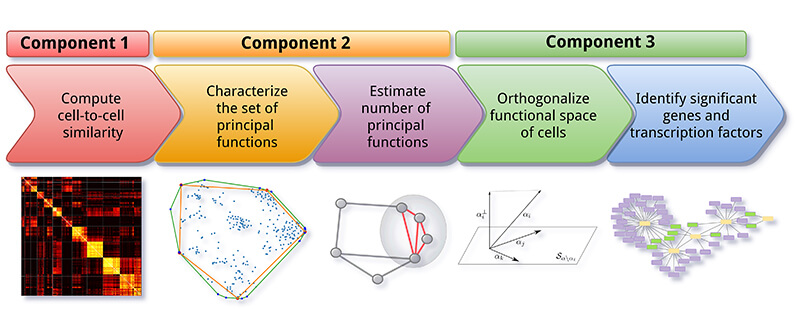June 11, 2018
New method for cell identification leads to discovery of melanoma subtypes
 The ACTION framework consists of five main steps. (Purdue University image)
Download image
The ACTION framework consists of five main steps. (Purdue University image)
Download image
WEST LAFAYETTE, Ind. — Cells have traditionally been categorized into different types, such as T-cells and B-cells, based on observable features. But new research published in Nature Communications shows cells are far more complex.
Purdue University researchers created an algorithm called ACTION to group cells based on their primary function and pinpoint the genes responsible for those functions. They also discovered a new subtype of melanoma, a form of skin cancer, which could lead to opportunities for more personalized therapies.
“We can interpret cells as types, but we should really think of them in terms of their functions,” said David Gleich, an associate professor of computer science at Purdue. “They’re not all purely one type. For example, our measurements can tell us if a cell is performing 80 percent one function and 20 percent another.”
Not only is there variation in tasks performed by individual cells in one region, but cells also behave differently in different scenarios. Cells behave differently around a tumor than they would other places in the body, Gleich said. This information can be measured with high-resolution gene expression readings of individual cells.
The ACTION framework helps break down this information and fully characterize the functional profile of a cell. It has three major components: identifying the functional identity of cells, classifying them based on their dominant function, and reconstructing regulatory networks responsible for mediating their identity.
The newly uncovered subtypes of melanoma have different survival rates and therapeutic responses than standard melanoma. Factors that mediate cell function and switches that turn functions on and off were identified for these new subtypes, providing new biomarkers and potentially targets for future drugs.
“Our understanding of how human biology works is continuously evolving, and every time we get access to more refined data, we need new methods to help us refine our understanding,” Gleich said. “Using a program like ACTION, we could acquire a functional landscape of cells for each person, which would allow us to do micro-targeting and really embrace the idea of precision medicine.”
Ananth Grama, Gleich, Shahin Mohammadi and Vikram Ravindra collaborated on this work. Funding was provided by the National Science Foundation and the Center for Science of Information, the DARPA SIMPLEX Program, the Sloan Foundation and the National Institutes of Health.
Writer: Kayla Zacharias, 765-494-9318, kzachar@purdue.edu
Source: David Gleich, 765-496-7300, dgleich@purdue.edu
Note to journalists: For a copy of the journal article, please contact Kayla Zacharias, Purdue News Service, 765-494-9318, kzachar@purdue.edu
ABSTRACT
A geometric approach to characterize the functional identity of single cells
Shahin Mohammadi, Vikram Ravindra, David F. Gleich, Ananth Grama
Single-cell transcriptomic data has the potential to radically redefine our view of cell-type identity. Cells that were previously believed to be homogeneous are now clearly distinguishable in terms of their expression phenotype. Methods for automatically characterizing the functional identity of cells, and their associated properties, can be used to uncover processes involved in lineage differentiation as well as sub-typing cancer cells. They can also be used to suggest personalized therapies based on molecular signatures associated with pathology. We develop a new method, called ACTION, to infer the functional identity of cells from their transcriptional profile, classify them based on their dominant function, and reconstruct regulatory networks that are responsible for mediating their identity. Using ACTION, we identify novel Melanoma subtypes with differential survival rates and therapeutic responses, for which we provide biomarkers along with their underlying regulatory networks.

